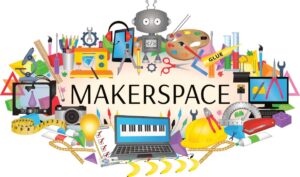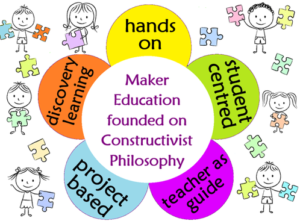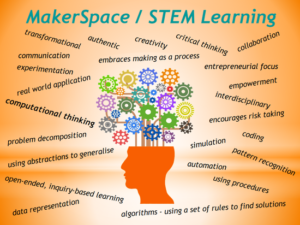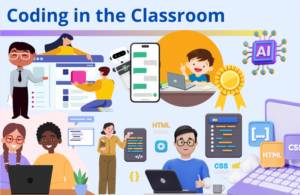Reflection on Investigating Creative Learning Environments with Coding and Maker Spaces”
Prior to this class, the realms of Coding and Maker Spaces remained uncharted territory for me. Despite having siblings who are engineers and having studied Informatics Practices in high school, the idea of delving into Coding had never crossed my mind. I harbored the misconception that it was a complex . The innovative approach to introducing Coding and Maker Spaces sparked a newfound interest in me. Through their guidance, I realized the potential for incorporating Coding into educational curricula. Although I’ve yet to teach Coding to my students, I’ve observed a growing popularity of Coding and Maker Spaces in our country. Numerous private companies now offer short-term courses in these areas, signaling a burgeoning interest and demand for such skills.
The innovative approach to introducing Coding and Maker Spaces sparked a newfound interest in me. Through their guidance, I realized the potential for incorporating Coding into educational curricula. Although I’ve yet to teach Coding to my students, I’ve observed a growing popularity of Coding and Maker Spaces in our country. Numerous private companies now offer short-term courses in these areas, signaling a burgeoning interest and demand for such skills.
 As technology continues to assume a more prominent role in education, there is a simultaneous increase in both student demand and interest levels. In response, educational institutions are integrating concepts such as STEAM (Science, Technology, Engineering, Arts, and Mathematics), robotics, coding, and maker spaces into their curricula. These initiatives are designed to offer students technical exposure, proactive training, and differentiated instruction.Presently, students benefit from having these concepts seamlessly integrated into their educational journey. Beginning as early as preschool, children as young as three years old are introduced to foundational concepts of technology education within their classrooms. What initially comprises hands-on, device-free STEAM experiences gradually progresses into more intricate technical instruction, incorporating the use of new and innovative equipment and software programs.
As technology continues to assume a more prominent role in education, there is a simultaneous increase in both student demand and interest levels. In response, educational institutions are integrating concepts such as STEAM (Science, Technology, Engineering, Arts, and Mathematics), robotics, coding, and maker spaces into their curricula. These initiatives are designed to offer students technical exposure, proactive training, and differentiated instruction.Presently, students benefit from having these concepts seamlessly integrated into their educational journey. Beginning as early as preschool, children as young as three years old are introduced to foundational concepts of technology education within their classrooms. What initially comprises hands-on, device-free STEAM experiences gradually progresses into more intricate technical instruction, incorporating the use of new and innovative equipment and software programs.
 This progressive educational approach ensures that students not only become familiar with technology from a young age but also acquire the skills and knowledge necessary to navigate an increasingly digital world. By incorporating these concepts into the curriculum, educational institutions are effectively preparing students to excel in an ever-evolving technological landscape.
This progressive educational approach ensures that students not only become familiar with technology from a young age but also acquire the skills and knowledge necessary to navigate an increasingly digital world. By incorporating these concepts into the curriculum, educational institutions are effectively preparing students to excel in an ever-evolving technological landscape.
Coding fosters learning through hands-on engagement.Children learn best when actively engaging in hands-on exploration. This concept, advocated by American philosopher John Dewey, underscores the importance of interactive learning experiences where students immerse themselves in their surroundings to adapt and acquire knowledge. Learning by doing emphasizes that individuals learn more effectively through active participation rather than passive observation.For instance, imagine a child learning to play a game.
 Through the learning-by-doing approach, the child gains a comprehensive understanding of the game’s mechanics and features. As they progress, they delve into various elements such as object manipulation and scoring, fostering active involvement and prompting them to identify and rectify errors.Introducing children to coding unlocks a myriad of opportunities. It allows them to create games, apps, animations, and more, all while enjoying the creative process. Coding goes beyond computer science, instilling invaluable problem-solving, organizational, mathematical, storytelling, and design skills. Additionally, it empowers children to transition from passive consumers to innovative creators, encouraging them to perceive technology as more than just entertainment but as a platform for problem-solving and creative expression.
Through the learning-by-doing approach, the child gains a comprehensive understanding of the game’s mechanics and features. As they progress, they delve into various elements such as object manipulation and scoring, fostering active involvement and prompting them to identify and rectify errors.Introducing children to coding unlocks a myriad of opportunities. It allows them to create games, apps, animations, and more, all while enjoying the creative process. Coding goes beyond computer science, instilling invaluable problem-solving, organizational, mathematical, storytelling, and design skills. Additionally, it empowers children to transition from passive consumers to innovative creators, encouraging them to perceive technology as more than just entertainment but as a platform for problem-solving and creative expression.
I like the idea of kids starting early so that creating becomes a habit and then Coding and makerspace will get their real due.
Thanks Mandeep for your valuable feedback
Hi Suruchi!
Thank you very much for sharing your insightful analysis of your exploration of the worlds of maker spaces and coding. It’s encouraging to see how your viewpoint has changed and how you’ve realized how much opportunity there is to include these ideas in curriculum. Your remark regarding the rising demand for Coding and Maker Spaces in our nation is indicative of a larger movement in favour of using technology in the classroom. Your excitement for experimenting with novel pedagogies and methods of instruction is admirable, and I look forward to seeing how you keep implementing these cutting-edge ideas in your lessons. Continue your amazing effort!
Thank Honey for your feedback , your insightful analysis of the blog.
Suruchi, your reflections on navigating the realms of Coding and Maker Spaces are insightful and inspiring. Your journey from initial hesitation to newfound interest showcases the transformative power of innovative educational approaches. Your observations on the integration of STEAM concepts and hands-on learning underscore the importance of preparing students for a digital future. Keep sharing your experiences and insights as you continue to explore and advocate for the integration of technology education in the classroom.
Comment
christina Thank you so much for your encouraging words and thoughtful reflection on my blog post. I truly appreciate your support and am grateful for your insights.
hey dida,Your thoughts show how you discovered coding and maker spaces and why they’re becoming more important in schools. You talk about how hands-on learning is helpful and how coding helps kids be more creative and better at solving problems. The simpler version of your ideas explains these complicated topics in an easy way so everyone can understand why they’re so important. Your thoughts add to the talk about using technology in schools and getting kids ready for the future. Keep learning and telling others about your experiences with coding and maker spaces—it’s great to see how much you like these things!